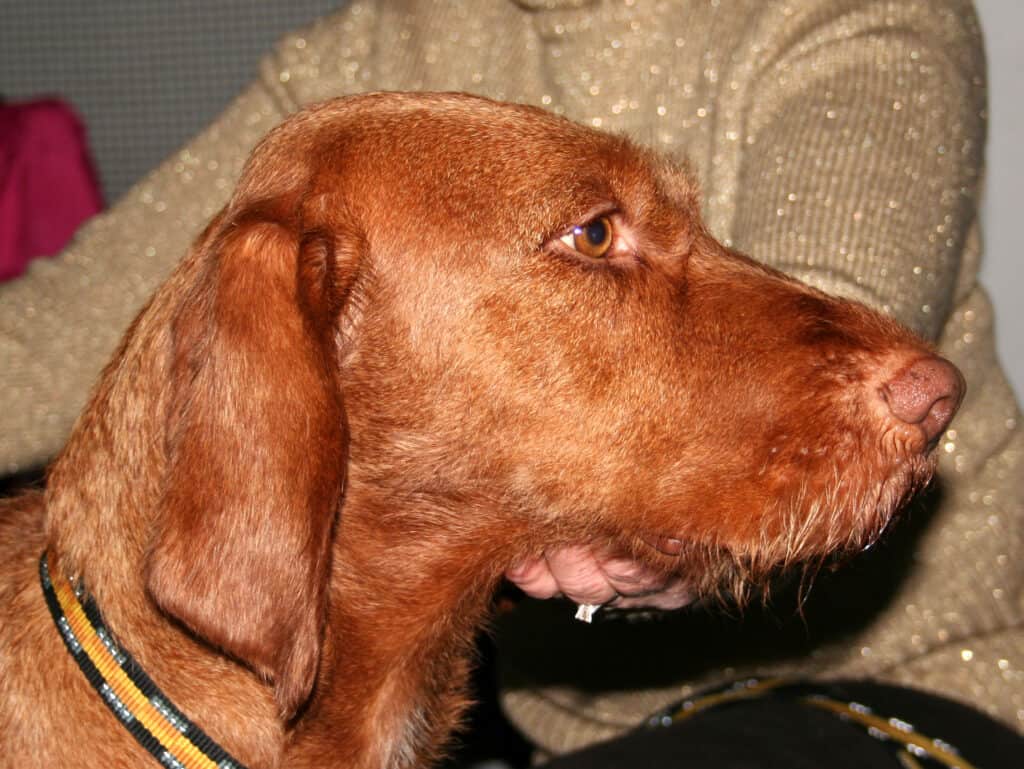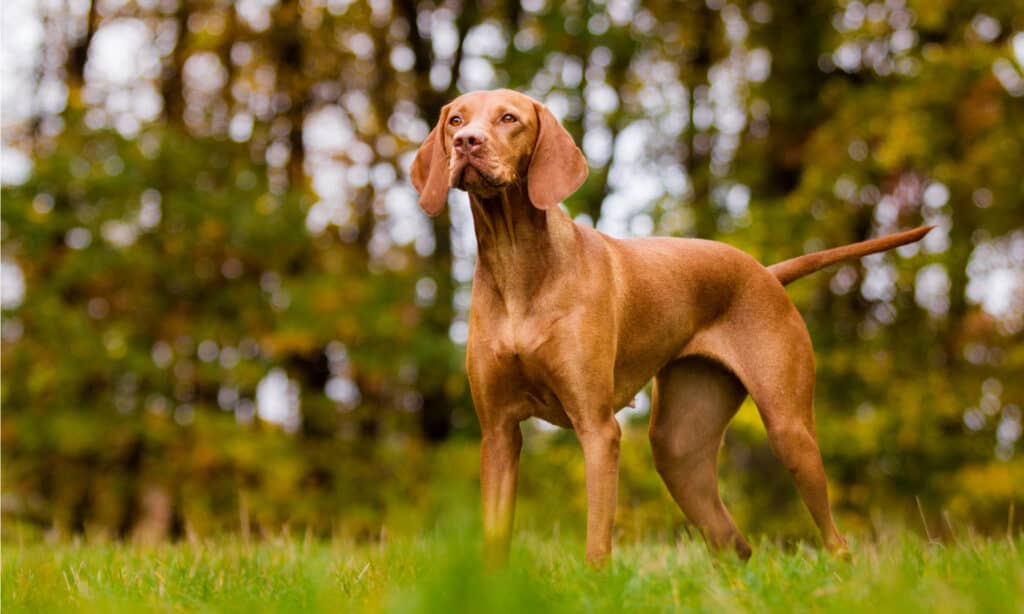Vizslas are gun dogs that originated in Hungary. They are often called the Hungarian Pointer or the Hungarian Vizsla. Vizslas are medium-sized hunting dogs recognized by the AKC and weigh, on average, about 57 pounds. These dogs are often confused with Redbone Coonhounds, Weimaraners, or Rhodesian Ridgebacks. They are energetic, lightly built, agile, and robust. The Vizsla is the perfect dog for hunting, field trials, and other fun dog activities, as they are eager to be active and learn. They have sleek bodies with docked tails and powerful chests. In addition, they are stunning to look at, as their facial characteristics blend wonderfully with their coat. The AKC recognizes most Vizsla colors, but no matter the color, these dogs are magnificent.
Vizslas were used to develop other dog breeds, such as the Wirehaired Vizsla, the German Shorthaired Pointer, and the Weimaraner. These beautiful dogs have a rough history; they were very close to extinction. However, many Hungarians took their Vizslas with them when they fled to other parts of Europe during the Russian Occupation of World War II. That is how the breed spread through Europe and eventually the West.
Breed Standards
These dogs have smooth, short, and dense coats. The AKC puts importance on the coat being short. Also, these dogs have no undercoats, resulting in less shedding than dogs with undercoats. However, they shed moderately, which can be problematic for people with allergies. Vizslas are not hypoallergenic, but grooming them is not hard work. The most common Vizsla colors are golden rust, red, and Golden. Also, Vizslas are usually self-colored (one color), so most of their features blend nicely with their dusky coats. This is very helpful when they are out hunting and must camouflage themselves. The AKC recognizes 7 Vizsla colors. Here they are from rarest to most common.

Vizslas are the perfect dogs for hunting, field trials, and other outdoor activities as they are eager to be active and quick to learn.
©Tomas Maracek/iStock via Getty Images
1. Rust Golden
These Vizslas have a warm russet-toned coat with a touch of gold. It is the rarest coat color. Their nose and the skin around their eyes often have more reddish undertones. Also, there is evidence that rust golden Vizslas were used in hunting wild animals in the 14th century in the central grassland in Hungary. These dogs’ somewhat greasy coats make them ideal for working in high temperatures in the fields.
2. Rust Vizsla
The rust Vizsla is orange-brown with lighter brown on the neck and shoulders. This gives them a sort of “saddle” smirch.
3. Sandy Yellow
Vizslas that are sandy yellow have mostly blonde fur with different shades of yellow. This coat color is very rare.
4. Red Golden Vizsla
The AKC approves the red golden coat color. These Vizslas are reddish-gold, usually with mahogany or amber pigments. However, sometimes they can be darker brown, but they will most certainly have a reddish tone to their coats.
5. Golden Vizsla
This is a lighter version of the golden rust Vizsla. This color variant has delicate yellowish undertones with a golden shade on the coat.

This is a lighter version of the golden rust Vizsla.
©Ksenia Raykova/Shutterstock.com
6. Red Vizsla
Red Vizslas have a reddish color all over their bodies. However, they do have lighter shades of this color around their neck and shoulders. The red Vizsla appears more like a rusty brown shade, and it takes one set of dominant red genes to produce red Vizsla puppies.

Red Vizslas have a reddish color all over their bodies. However, they do have lighter shades of this color around their neck and shoulders.
©Pleple2000/CCBYSA2.0 – License
7. Golden Rust Vizsla
The golden rust Vizsla is the standard color of this breed. They have one solid color, which is golden rust. They appear light brown but have darker muzzles. This is the most common Vizsla color.

The golden rust Vizsla is the standard color of this breed. They have one solid color, which is golden rust.
©Aneta Jungerova/Shutterstock.com
Vizsla Origins
These dogs have a long and fascinating past. It is believed that they originate from the lineage of hunting dogs that the Magyar tribe brought over to Hungary. Stone etchings that have been discovered depict this dog with a hunter and a flacon, proving that the Vizsla’s descendants were important and notable many years ago. The Magyar tribe sought out the Vizsla that we know and love for being strong and fast. These dogs are the oldest of the great European Vorstenhhund dog breeds. They were bred for pointing and retrieving.
Furthermore, their bloodline was kept pure because people saw that the breed was very carefully guarded. In addition, this dog breed survived many terrible events throughout history, which includes the Hungarian Civil War and the Turkish occupation. The Vizsla as we know it almost went extinct at the end of the 19th century.
Personality
Vizslas are known for being courageous and brave. They might give off a formidable appearance. However, they are affectionate, sensitive, and gentle. Because of their hunting genes, they do have high energy levels and therefore need a lot of attention. Consequently, they are not ideal for people who live busy lives and do not have time for them. Also, they are not recommended for novice owners. However, people who have experience with high-energy dogs would be able to handle this breed. In addition, they do well around people, and their friendly nature creates wonderful friendships with children. They fair well with all age groups. However, they should be supervised around younger children, as they can get over-excited and knock small kids over unintentionally.
Additionally, they are excellent watchdogs who protect their families from any situation they deem dangerous. But, due to their friendly nature, they are not very intimidating and will not make very good guard dogs. In saying that, they will let you know if someone is approaching. Vizslas have worked in many service jobs over the years, including:
- Detective jobs for the TSA
- Seeing eye dogs
- In the K-9 units
- As therapy dogs
Unfortunately, they are unsuitable for living with other house pets, such as hamsters, reptiles, and birds. This is due to their high energy levels, which cause problems at some stage. However, with proper socialization, they get along wonderfully with other dogs. Lastly, they love cuddles and make great lap dogs.
Life Expectancy
The life expectancy of a Vizsla is about 12 to 15 years. However, this is up to the owner and how they care for the dog. All dog breeds should be acquired from a reputable breeder or rescue with all the correct health checks to ensure a long and healthy life.
Health Issues
Vizslas are generally healthy. However, like all dog breeds, there are specific health issues to look out for. That is not to say that all Vizslas will suffer from these problems. However, if you plan on getting a Vizsla, you should keep these potential conditions in mind.
- Canine hip dysplasia: an inherited condition that manifests in the thigh bone, which does not fit into the hip joint. It could lead to lameness or pain in one or both legs.
- Epilepsy: a condition that causes seizures. However, it can be treated with medication, and the dog can live a relatively normal life.
- Progressive retinal atrophy (PRA): a degenerative eye disorder that will, in the long run, lead to blindness.
- Hypothyroidism: the thyroid gland is unable to produce enough hormones. Signs of this disorder include infertility, mental dullness, irregular heat cycles, obesity, dropping of the eyelids, and low energy levels. Also, the dog’s coat could become coarse and brittle with more than average shedding and tough, dark skin. Luckily, this condition can be treated with medication.
- Lymphosarcoma: one of the most common cancers found in dogs that can occur in the bone marrow, liver, gastrointestinal tract, spleen, and lymph nodes. It is most commonly treated with chemotherapy.
Summary of Viszla Color: Rarest to Most Common
| Coloration | |
|---|---|
| 1 | Rust Golden |
| 2 | Rust Vizsla |
| 3 | Sandy Yellow Vizsla |
| 4 | Red Golden Vizsla |
| 5 | Golden Vizsla |
| 6 | Red Vizsla |
| 7 | Golden Rust Vizsla |
The photo featured at the top of this post is © iStock.com/Anna Pozzi
Ready to discover the top 10 cutest dog breeds in the entire world?
How about the fastest dogs, the largest dogs and those that are -- quite frankly -- just the kindest dogs on the planet? Each day, AZ Animals sends out lists just like this to our thousands of email subscribers. And the best part? It's FREE. Join today by entering your email below.
Thank you for reading! Have some feedback for us? Contact the AZ Animals editorial team.







